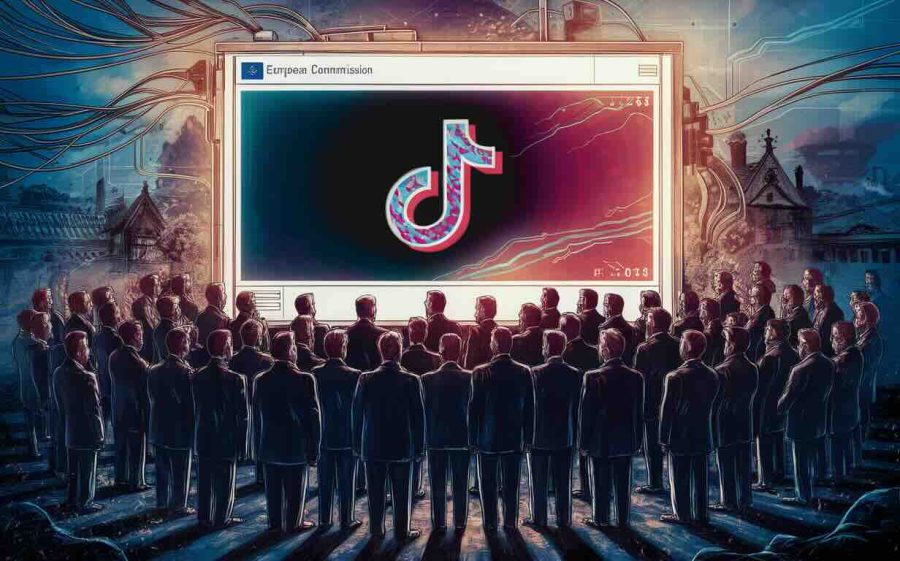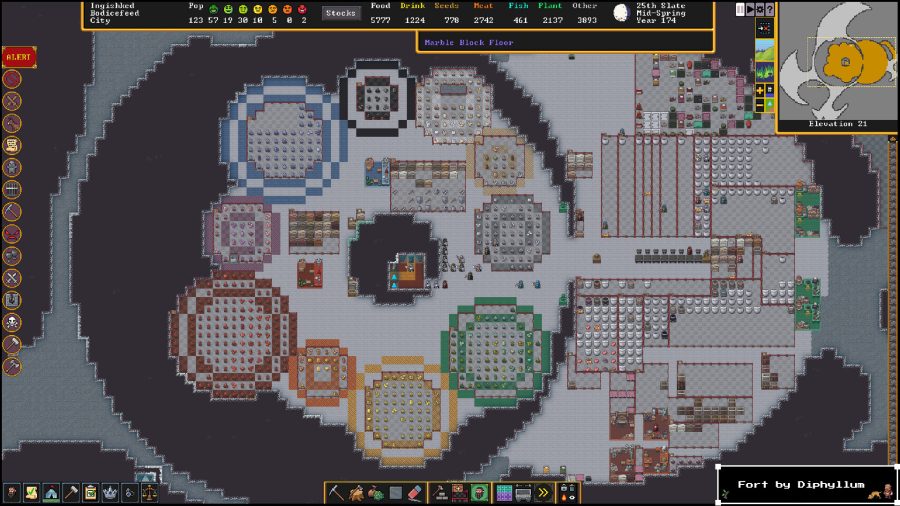Today, VMforce was officially unveiled by its parent organizations VMware and SalesForce. The companies came together to produce this love-child and are now proudly sharing it with the world. The new organization, VMforce is disruptive to the core premise and architecture, bringing a new generation mix of services and software to the enterprise.
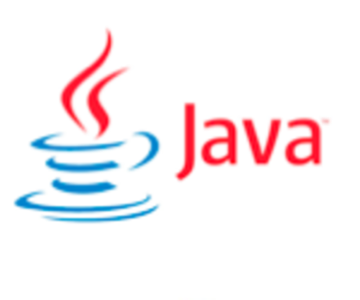
We took time to talk to leaders at SalesForce and VMware to absorb the news and start to dig in. In this post, we’ll share what we know and insert speculation in the force in the market this product may exert.
The VMforce Zen: Moving Java from Run Anywhere to Distribute Now
One of the best parts of our dialog with the company representatives Ariel Kelman, VP Platform Product Marketing of Salesforce.com and Jerry Chen, Senior Director, Cloud & Application Services at VMware was getting them explain how they came to the conclusion that the time was right to choose each other as key partners.
From the one side, we have VMware’s vSphere, vCloud and Spring as the entry point to building applications. On the other side we see this force of infrastructure mixed with the smoothness of SalesForce security, enterprise cloud readiness, and database in the cloud as an always-on set of services.

In essence, when looking at the respective synergies in these two key cloud providers we heard several times, from Kelman and Chen that it “just makes sense”.
Being curious about how both organizations grow, it was hard to disagree that a compelling opportunity exists – and that was before the slides that follow.
The VMforce Pitch
Here, we’ll take you through the pitch the company shared with us and analyze a few of the key parts of what is being prepared for the platform.
Many Enterprises Love Java
One of the nice things about VMware bringing Spring into the discussion is the focus on lightweight stack for Java development. Although several patterns are supported, a default paradigm is to combine top patterns in the Java language ecosystem including the combination of Spring, Tomcat, and Eclipse.

Secure Cloud Computing and Legacy System Harmony
One of the best parts of using virtual infrastructure is the ability to avoid the hardware sizing discussion. With VMforce, the dialog extends even further to include database layer that has been proven with mission critical applications. In a way, Java is fully prepared to be bundled with database in the cloud, so this makes a lot of sense for SalesForce to bring enterprises into its cloud.
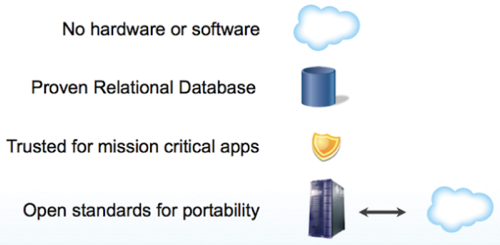
How VMforce Works
From the Java development point of view, it works like the past. But, from the smart infrastructure at your fingertips point of view, a new array of services now plug into the development tool set. This includes provisioning of the physical environment – including tuning and scaling. And it combines services offered by SalesForce in its cloud applications.
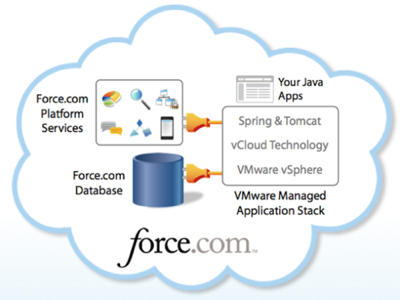
Developers Build Java Apps the Same Way
The incredible thing about this generation of tools, is the power that is added to the developer. The core application has always been “air traffic control” for many teams. Now, with the option to deploy to the cloud, we expect that application development will become more automated than ever before.
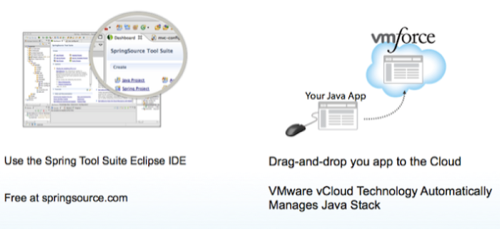
Database is Always On and Hosted in the Cloud
Have the Database in the cloud is an important strategic piece of this fabric. In essence, the crown jewels of architecture are being automated by applications. SalesForce with its scaling database technology, and VMware with it’s ability to monitor and provision architecture are working to take a whole layer of IT system design out of the mix by offering database and infrastructure as a service to each application deployed in VMforce.
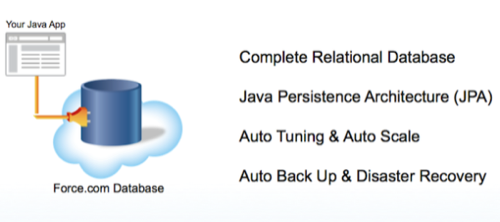
Developers Get Access to Force.com Business and Collaboration Services
One of the most compelling parts of this combination is the bringing of collaboration to the enterprise. With the momentum of SalesForce Chatter, it becomes easier and easier to see how enterprise teams may embrace SalesForce.com’s services into their applications.
Instead of learning Force.com APEX model, now the services can be brought into the application, and when hosted they can be tuned to peacefully exist within the cloud infrastructure and database layer.
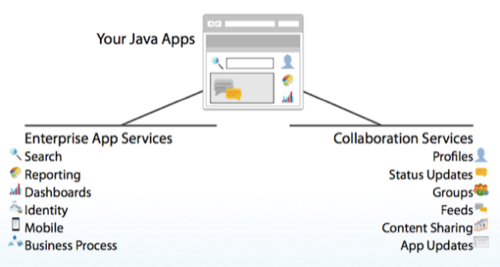
VMForce is More than Infrastructure
SalesForce has been seen as a platform as a service, whereas VMware and Amazon have been focusing on bringing infrastructure as a service. With this partnership, we (jokingly) like to think about it being platform as a service, with infrastructure inside (paaswii).
Here, the organization lays out its terminology and how infrastructure as a service like Amazon may be contrasted with VMforce.
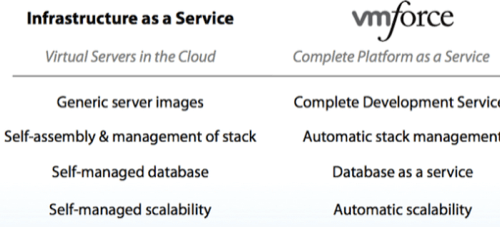
Together, SalesForce and VMware bring together infrastructure as a service and software as a service into a platform. SalesForce calls it Cloud 2. We simply consider it a next evolution of the thing we call the Cloud.
Demo: Competition Starts with Being There
Here’s the solution demonstration VMforce offers for developers that want to sign up for the preview beta.
Here are a few screen shots that the companies shared with us. This shows a first version of how VMforce services are consumed in SalesForce and managed in Force.com.

Here, we see sample applications in the VMforce console.
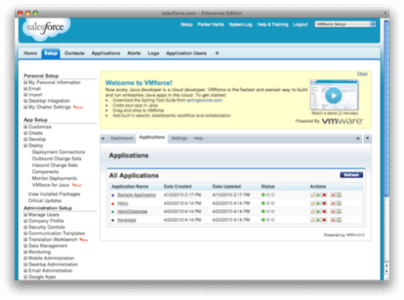
A Spring application in the VMforce console offers it services to the platform.
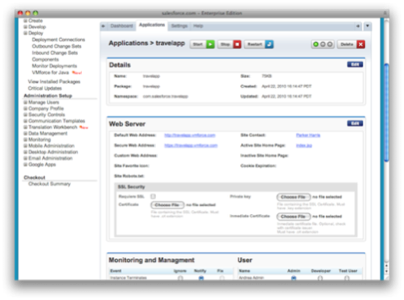
Spring for Java: Run, Java, Run
Java has had the pleasure of too much success, or at least success in some of the wrong places. With big supporters like IBM with WebSphere, BEA (now Oracle) and other models, the language has been tugged in several directions.
Still, it is a dominant language and development paradigm. Luckily, the wise sages within Java community have been working on deployment bundling and distribution of Java enterprises packages for a long time. At the same time, the pattern of Spring has been embraced by many developers have chosen a model to optimize towards for development.
VMforce, as it rolls out into 2010 may have the opportunity to become the heir-apparent to the thrones of historic greatness enterprise software by the likes of IBM, Oracle, Microsoft, and SAP. We think this is revenue opportunity for this effort.
At the same time, this move further evolves the competitive cycle of cloud computing and becomes more to those building services on the Amazon cloud, Google’s App Engine, and even vendors in the operating system layers including Microsoft, and RedHat.
A Few Questions to Consider
Here are a few questions to think about. As this rolls out, we hope to explore further as we watch the evolution of VMforce and Java as a cloud ready ecosystem.
- How does this help Java is what about iPhone, iPad? We wonder, could there be a model for this piece of the puzzle to be optimized so that enterprise developers who want to keep Java systems in place have a nice way to connect to the other models of computing such as Apple’s Objective C.
- What does it mean to be a first mover in Java cloud? Can, will this entry into Java bring it together, tear it apart, or other? Oracle and Sun are one, and IBM is still working to bring its cloud offerings to market. In a way, this move seems to force more scrutiny into the efforts at Oracle and its investment in Java. How will more competition shake up an already changing landscape?
- Will other platform as a service organizations respond? Google App Engine is targeting Java Developers, Heroku is suggesting Ruby as a model for enterprise web applications. Where will it shake out?
- Will partners emerge in the framework like they do today? We see a lot of goodness in the Spring, Tomcat and Eclipse development tools. Will other providers of Java services and software find a home in the VMforce curated cloud?
- Can SalesForce grow in both directions at once? In a way, SalesForce is moving both into lightweight (Twitter-like) applications and also heavy enterprise class services simultaneously. Perhaps it is needed for the end-game, but can it be done gracefully?
- What and where is the OS and choice? With this stack, it is increasingly obvious that in cloud based architecture, the OS (and database) fall into commodity. Are we ready for this? How do Microsoft, Redhat (and even Oracle) respond to show value for their respective layers of the IT infrastructure?
Is your Java ready to collaborate with the cloud?








